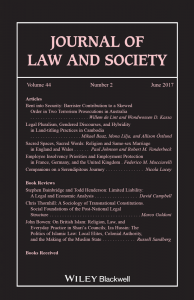Part II: The Effects of School Criminalization
 A few weeks back, I contributed a post highlighting possible explanations for the rise of criminal justice based practices within schools. Although these strategies have become popular for managing school crime, growing evidence suggests they are often overly excessive and may produce a host of unintended consequences. Serving as a sort of a Part II, this essay outlines the effects of what has been termed the “criminalization of school discipline” (Hirschfield & Celinscka 2011). As discussed below, the evidence stands against the school criminalization when considering its effects on: social equality, school performance, school crime, and other disciplinary strategies.
A few weeks back, I contributed a post highlighting possible explanations for the rise of criminal justice based practices within schools. Although these strategies have become popular for managing school crime, growing evidence suggests they are often overly excessive and may produce a host of unintended consequences. Serving as a sort of a Part II, this essay outlines the effects of what has been termed the “criminalization of school discipline” (Hirschfield & Celinscka 2011). As discussed below, the evidence stands against the school criminalization when considering its effects on: social equality, school performance, school crime, and other disciplinary strategies.
When examining the presence of punitive security measures in school, a growing body of evidence finds that they may disproportionately be placed in schools serving a large percent of racial/ethnic minorities. Additionally, evidence suggests that minority and economically disadvantaged students are more likely to receive harsh punishments within school in comparison to their counterparts – leading to what has been termed the “school to prison pipeline”. Kupchik (2010) more broadly illustrates that the trend of school criminalization has been widely felt, that school across the nation – no matter their student population – have all adopted similar harsh, exclusive security strategies.
To further understand the unequal application of school security, scholars have recently examined how minority and poor youth are perceived within the school environment. This literature reveals that these youth are subject to negative perceptions held by school staff. Specifically, minority and poor youth are often (mis)perceived as troublemakers, disruptive, disrespectful, and a challenge to authority. Whether because of race- and class-based stereotypes, their perceived racial threat, or that their posturing, speech, style, and manners do not reflect White middle class norms, evidence suggest that school staff are more prone to punish these youth given the rise of harsh security based practices.
Scholars have also found that schools with harsher disciplinary practices experience lower levels of school performance. More specifically, exclusive based strategies are negatively related to higher dropout rates. Research also finds that the use of criminal justice tactics in schools has the ability to decrease student attendance, SAT taking, and student engagement. In that same vein, mounting evidence shows that such tactics have the ability to create a undesirable school climate and negatively impact the quality of education. Additionally, there is no clear evidence that the criminalization of school discipline is more effective at preventing school violence than prior practices. For example, literature examining the impact of school resource officers on student’s views and attitudes towards offending, found no significant impact. In fact, studies suggest that harsh disciplinary practices may increase student misconduct.
Aside from evaluative efforts, the literature reveals that the rise of school criminalization has placed emphasis on rule compliance above all else. Despite school staff wanting to help resolve student issues, they have become bound to rules that view misconduct through the prism of crime control. Consequentially, counseling based initiatives often fall behind harsh punishments which do little to address underlying problems. Although originally thought to curb violence in schools, he and others conclude that criminal justice based practices in school open the door for harsher punishments that are potentially more damaging to youth and school.
Although the current practices comprising the criminalization of school discipline echo larger rationales of crime control, perhaps it is time to step back and take a critical look at their impact on youth (and larger society). Though tighter security practices were established to curb school crime and keep our youth safe, mounting evidence suggests that the practices associated with modern school discipline have begun targeting youth instead.
Read: Hirschfield, P. and Celinska, K. 2011. Beyond Fear: Sociological Perspectives on the Criminalization of School Discpline. Sociologu Compass, 5(1): 1-12
Read: Kupchik, A. and Ellis, N. 2007. School Discpline and Security: Fair for all Students? Youth and Society, 39(4): 549-574




1099-0860/asset/NCB_logo.gif?v=1&s=40edfd0d901b2daf894ae7a3b2371eabd628edef)
1 Response
[…] Sociological Lens. More on the school-to-prison pipeline. […]